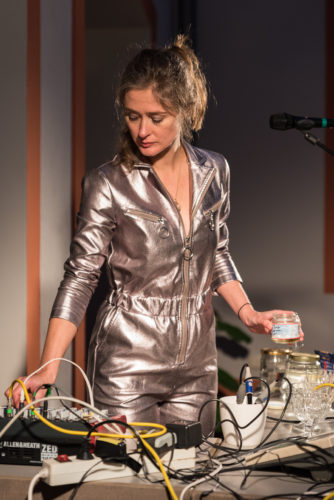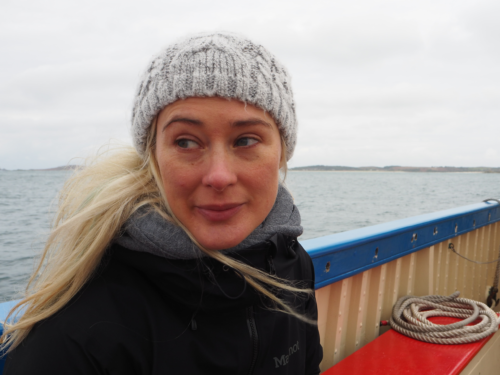
Kat Austen is a creative, forward-thinking, and interdisciplinary artistic researcher. Focusing on climate change and environmental justice issues such as food access and microplastics, she melds science, social change, and art through sculptures and installations, performances, experimental music, and participatory workshops—all while being deeply rooted in science and theory. She draws motivation from imagining a future of social and environmental justice, as well as empathy between humans and non-humans. With a desire to increase active participation in “knowledge making” and social, political, and environmental agency, Kat integrates citizen science and participatory artistic research to engage communities and audiences in tackling problems of environmental inequity and societal power imbalances. Based in Berlin, she currently is a STARTS Repairing the Present Fellow at Ars Electronica and holds roles as an Artist in Residence and Senior Teaching Fellow at University College London. She has had installations and performances internationally.
ClimateMusic: You have worked on various research and artistic projects spanning from commentary on land use to experiments in empathy for coral reefs. How did you realize you wanted to incorporate environmental and social issues into your life’s work? What drew you to explore avenues for equitable and sustainable coexistence with other communities—whether human or non-human? Why have you chosen the integration of science and art to do so?
KA: From as early as I can remember, I was active for the environment. My mother took me on my first protest march before I could walk, and by the time I was 9, I was organising petitions for action against marine pollution. The motivation that has driven me through my life is to understand and address how we can live better with other(s) in the world, without drawing a distinction between the other(s) as human, non-human or more-than-human. This motivation was with me before I found the path that I could best follow to fulfill it. I took a rather round-about route to my practice—I initially trained in chemistry and researched environmental systems to address anthropogenic pollution. After switching to sculpture, I tried to leave scientific methods behind, but I found that there was a deep-seated understanding of the world that I had gained through my research that enriched my artistic research, and ultimately the artworks and compositions themselves.
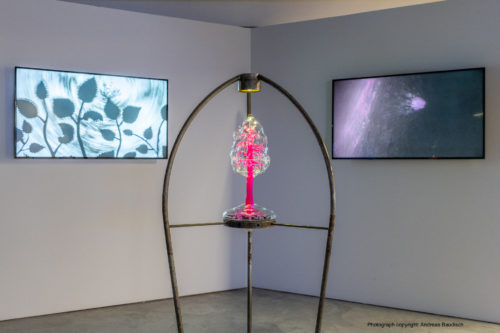
ClimateMusic: How has your artistic and research work, as well as your own perspective on the intersections of climate, research, justice, and social structures evolved or deepened since you first started with this work?
KA: Things have rapidly changed since I first started working on these topics. It has become increasingly apparent that to address complex global challenges requires diverse approaches that lie beyond the scope of one person or collective. What’s required is that systemic injustices and imbalances are addressed, and the relationship between humans and other entities on the planet must be radically reconfigured. Each year, there are advances in art, science, and traditional knowledge systems in terms of how to conceive the human relationship to complex ecological networks, and I incorporate these into my work by thinking about the subjectivity of non-humans / more-than-humans, addressing the legacy of colonialism, and incorporating listening and embodied knowledge into my practice. Yet these valuable insights have yet to make it into global political decision-making. Global decisions are needed so that infrastructure and systems can be adapted to stop getting in the way of environmental and social justice, allowing and reflecting a value system where sustainable practices and social justice are given the highest priority at all levels.
ClimateMusic: In your most recent album “This Land is Not Mine,” which was just released on January 27th, you tell the story of the Lusatia region’s degradation due to open cast mining, as well as other lands and villages damaged by unsustainable resource extraction. How did you learn about Lusatia and become invested in the region’s history?
KA: I wanted to work on a project that would allow me to look to the future, to move beyond the ecological grief with which I have been grappling for many years. I wanted to try to accept it, and in so doing, to learn how to move forward. Lusatia is a region very close to my home in Berlin, Germany. It’s a fascinating region, as its regional identity pre-dates the national borders of Germany, Poland, and the Czech Republic which now intersect it. There is also a minority population, the Sorbs, associated with the long history of this region, and they carry traditional and folkloric knowledge of the human-land relation there. Many of the villages destroyed by decades of open cast brown coal mining were Sorbian villages, which has been devastating to the communities living there. By the same token, mining in the region—as with mining in many areas—has been important to the regional and individual identity, particularly for those working in the industry, not to mention how economy and material provision of energy have been important to the wider region of Berlin-Brandenburg. This complex and contested landscape resonates with me because it’s a borderland, post-industrial and post-extractive. I wanted to get to know it and understand how its multiplicity of identities are changing in this process of transition, especially as the mines close down and the region—the land, the rivers, the ecosystem, the people—encounter a post-extractive reality.
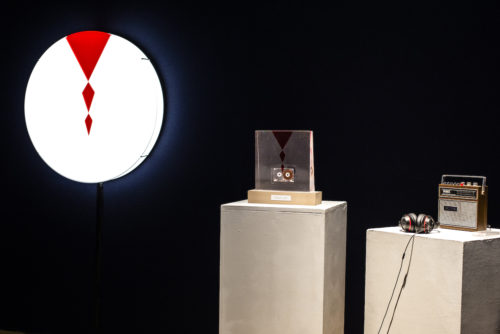
ClimateMusic: You also utilized integrated acoustic and electronic sound with crowdsourced field recordings of Lusatia in the creation of “This Land is Not Mine.” Can you tell us what this artistic and scientific process was like for you? How did you come to choose sound as a means of expressing Lusatia’s conditions? Was it difficult to navigate combining these various aspects to produce a cohesive, storytelling sound?
KA: Yes, my process involves first making field recordings and recording videos as I get to know the landscape and encounter it bodily. When working with landscape, my first approach tends to be through sound—it’s the mode through which I make the most emotional connection with other landscapes or creatures. As part of my practice, I also take water and soil samples and use them in conjunction with some special audio instruments that I made by adapting scientific measuring devices. I play these when I perform my compositions live, and it gives me another way to understand the processes occuring in the landscape because it hints at the physical and chemical processes that are part of the dynamism of the planet. Even when things look static to us, everything is always changing, moving, and reacting—the molecules in the air are flowing around, our bodies are full of constant chemical reactions, the surface of a rock in a river is slowly dissolving, and new crystals grow as the water flows over it… Even something as solid as a desk is full of vibrating atoms. I like to stay connected to this constant motion. The rhythms of these things—along with larger things like the wind in the trees, the water flowing over a weir, and the sound of traffic—all help to form the structure of the music I compose.
When it came to Lusatia, it was a challenge to come to terms with such a vast and varied ecosystem with such multiple scales. I knew I wanted to see beyond what was commonly known about the region, beyond the mining. Going there, it’s not difficult to see why a lot of attention is given to the open cast mines. They are epic—the sheer scale of the machinery, the vast tracts of land that have been stripped to remove the two layers of lignite hiding beneath. But there’s a saying in Lusatia that gives a hint at what I was looking for: “God made Lusatia, and the Devil put coal under it.” What was there beyond the mines? I went looking. What I found was complexity, diversity, heterogeneity. It wasn’t possible to provide a cohesive story, but it was possible to tell my stories of what I had found, while simultaneously showing that there are so many more stories beyond the vignettes I create. So, I structured the work as a protest album, with each song the story of a moment in time of one character from Lusatia—be they human or non-human. There’s a song of those looking for lost villages, a song of the coal, a song of the Sorbs through time, a song of one of the rivers… Each song is as different as the perspectives of the characters, and together they show the lovable ungraspability of post-extractive Lusatia.
ClimateMusic: In “This Land is Not Mine,” as well as other projects, you have drawn on crowdsourced data, DIY and citizen science, and participatory research to communicate the urgency of environmental crises. In your recent album, what value do you see in using the crowdsourced field recordings to inform and produce your art? Why is it important to you to engage the public in your projects?
KA: It was really important to me to connect with people in Lusatia to understand their perspective on the landscape. While the outcome is my synthesis of what I encountered there, I knew that there would be some aspects that I couldn’t uncover on my own, working over only a short period of a year’s research. It’s also part of my practice to share my research methods. I have found these methods—from artistic research to DIY science—very transformative for myself and how I relate to the world and recognise my own environmental, social, and political agency. As such, I want to share these methods with others in case they find them beneficial. For “This Land is Not Mine,” my initial intention was to carry out the participatory research in person through a series of workshops and one-on-one encounters. However, the start of the project, which began through an artist fellowship at the Institute of Advanced Sustainability Studies, Potsdam, coincided with the beginning of the pandemic. In those turbulent times, it was only possible to realise one workshop, in which we listened to nearby water from our base at the Brandenburg Museum for Contemporary Art in Summer 2020. So, we devised a crowd-sourcing platform, lausitzklang.katausten.com, where I offer videos of how to engage with listening and field recording, along with an opportunity for people to upload and share their recordings of sounds they identify with Lusatia. I used some of these recordings in the compositions for the album and the interactive soundscape I am designing for the “This Land is Not Mine” installation. I also share my own field recordings, including through a bespoke package that will soon be released on audio software Soniface, which is co-developed by one of the Sorbian community members born in Lusatia. It’s my hope that through these methods, I can contribute to a change in how people value and interact with the landscape and other entities that share it.
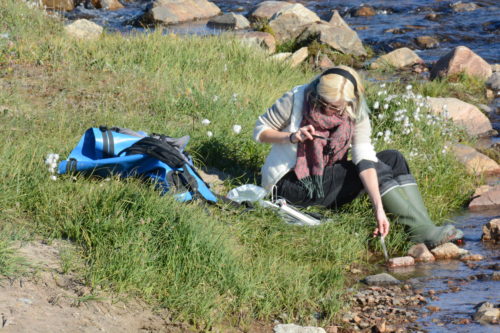
ClimateMusic: Your research and artistic interests have been boundary-breaking and transdisciplinary in topics spanned and media used. How do you view your projects and work as a unique means of communicating the climate crisis and invoking social and political agency?
KA: Thank you! I view my work as part of a network of projects being realised using diverse approaches to address the climate crisis. My own efforts work through engendering empathy for other lifeforms and ecosystems by creating emotional connections. By offering spaces that allow people to encounter, think about, and experience the world in ways they may not be used to, my work contributes to growing bodies of knowledge about human-environment entanglements. My methods will only speak to certain people, and I take a lot of emotional nourishment from the fact that so many others are making it their life’s work to address the same challenges in ways that I hope will touch enough people that we will finally, materially avert a climate catastrophe.
ClimateMusic: Thank you for sharing your experiences and perspectives with us! If you can share, what projects are you now working on, and how can folks stay updated on all of your incredible work?
KA: Thank you for having me. Things are very exciting at the moment—I am finalising the installation for “This Land is Not Mine,” which will open alongside my work “Stranger to the Trees,” an installation about microplastic interaction with trees, at the Water Reservoir exhibition space in Berlin on Earth Day, 22nd April. It will be complemented by a performance of the album on the 30th April. I am also working on the release of the “This Land is Not Mine” album on the first ever bioplastic composite LP record, through the project Circular Records, in collaboration with artist and designer Fara Peluso.
Website: https://www.katausten.com
“This Land is Not Mine” available on Bandcamp: https://katausten.bandcamp.com
